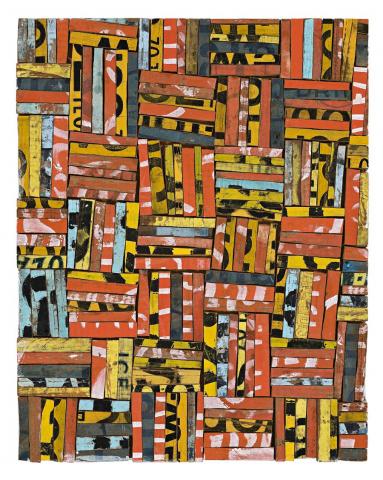TESSERAE 2, 1989
ROSALIE GASCOIGNE
sawn and split soft drink crates on plywood
46.0 x 36.5 cm
signed, dated and inscribed with title verso: TESSERAE 2 / 1989 / Rosalie Gascoigne
Roslyn Oxley9 Gallery, Sydney
Private collection, Brisbane
Rosalie Gascoigne, Roslyn Oxley9 Gallery, Sydney, 1 – 18 November 1989, cat. 21 (label attached verso)
Fern, L., 'Rosalie Gascoigne', Interior Architecture and Design, Issue 23, 1989, p. 183
Marriage Feast, 1988, sawn and split soft-drinkcrates on plywood, 119.4 x 106.0 cm, collection of the National Gallery of Australia, Canberra
'You go out, and you think, 'I'll have that, I'll have that', and you don't care what you are doing with it. You just know it's good, so that the hunting and finding bit is part of the oeuvre. I take great delight in that, same as I take delight in hardening my vision.'1
Tesserae, a latin word, refers to the small pieces of glass or ceramic used in mosaic and in antiquity it could also mean small squares of bone or wood used as a token or a tally. The word tessellation in architectural contexts refers to the arrangement of tiles into a repeating geometric pattern. As a concept it is at the heart of all that Rosalie Gascoigne created as the great collector and re-organiser of the world's discarded and unwanted surplus. All of her work is a type of organic tessellation and in some of her most loved installations she used the great hoard of soft drink crates she found at the Schweppes depot in Queanbeyan in the early 1980s. This culminated in a watershed solo exhibition at Roslyn Oxley9 Gallery in 1989, which included the monumental work, Monaro (Art Gallery of Western Australia) and All That Jazz (Private collection). In this series she took humble soft drink crates, cleaned them, broke them into thousands of pieces and in reassembling them in her own inimitable way she transformed the precious tesserae into landscapes of the imagination, musical evocations, flowers and deep ideas. Tesserae 2 is part of a group of four works included in that same critical exhibition, which explore the idea of recurring patterns under the influence of Gascoigne's rare sensibilities. The use of panels from red and blue boxes alongside the tell tale yellow Schweppes crates in this work hark back to an earlier more minimalist work, Parrot Country,1983 (Gascoigne Estate) which was greatly admired by James Gleeson. The arrangement of these colours took on a special significance for Gascoigne and in 1989 she gave a larger version of Tessarae 2 as a wedding gift to her son Martin. She called it Wedding Feast (Australian National Gallery) and it is these slightly weathered but jewel-like primary colours which gives it an energy and exuberance so deeply characteristic of Gascoigne's metier.
1. Eagle, M., From the Studio of Rosalie Gascoigne, The Australian National University Drill HallGallery, Canberra, 2000, p. 10
LARA NICHOLLS
